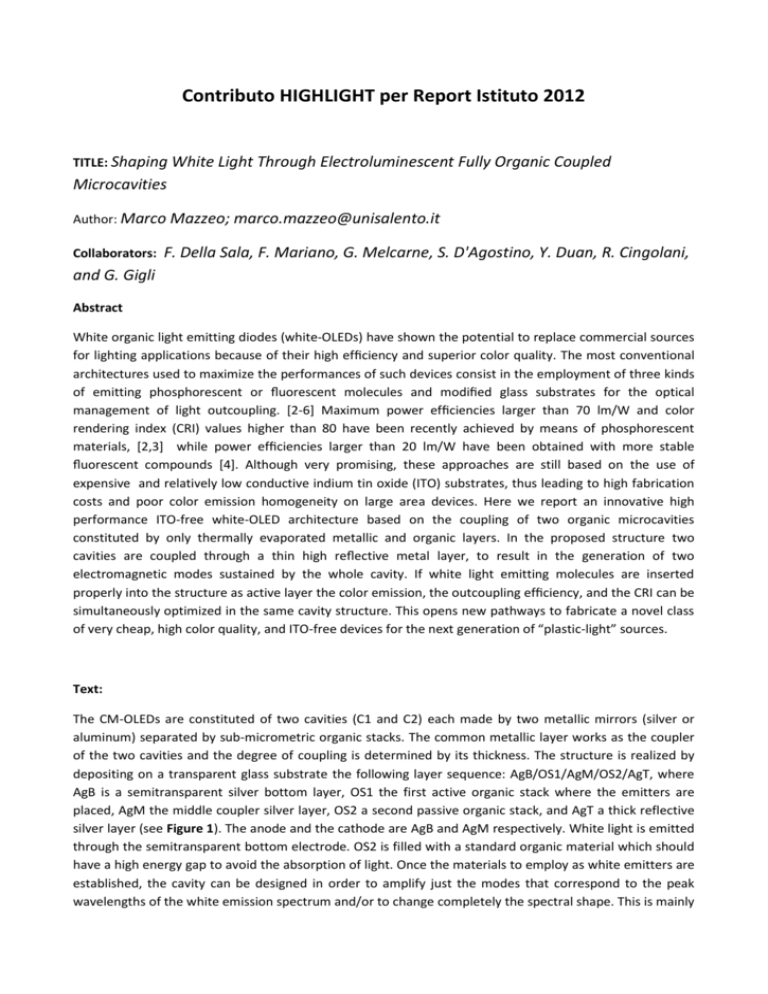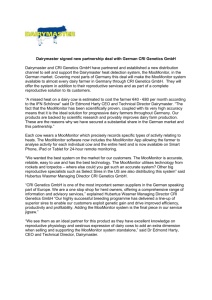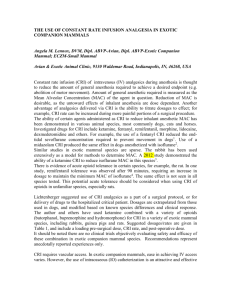Contributo HIGHLIGHT per Report Istituto 2012
advertisement

Contributo HIGHLIGHT per Report Istituto 2012 TITLE: Shaping White Light Through Electroluminescent Fully Organic Coupled Microcavities Author: Marco Mazzeo; marco.mazzeo@unisalento.it Collaborators: F. Della Sala, F. Mariano, G. Melcarne, S. D'Agostino, Y. Duan, R. Cingolani, and G. Gigli Abstract White organic light emitting diodes (white-OLEDs) have shown the potential to replace commercial sources for lighting applications because of their high efficiency and superior color quality. The most conventional architectures used to maximize the performances of such devices consist in the employment of three kinds of emitting phosphorescent or fluorescent molecules and modified glass substrates for the optical management of light outcoupling. [2-6] Maximum power efficiencies larger than 70 lm/W and color rendering index (CRI) values higher than 80 have been recently achieved by means of phosphorescent materials, [2,3] while power efficiencies larger than 20 lm/W have been obtained with more stable fluorescent compounds [4]. Although very promising, these approaches are still based on the use of expensive and relatively low conductive indium tin oxide (ITO) substrates, thus leading to high fabrication costs and poor color emission homogeneity on large area devices. Here we report an innovative high performance ITO-free white-OLED architecture based on the coupling of two organic microcavities constituted by only thermally evaporated metallic and organic layers. In the proposed structure two cavities are coupled through a thin high reflective metal layer, to result in the generation of two electromagnetic modes sustained by the whole cavity. If white light emitting molecules are inserted properly into the structure as active layer the color emission, the outcoupling efficiency, and the CRI can be simultaneously optimized in the same cavity structure. This opens new pathways to fabricate a novel class of very cheap, high color quality, and ITO-free devices for the next generation of “plastic-light” sources. Text: The CM-OLEDs are constituted of two cavities (C1 and C2) each made by two metallic mirrors (silver or aluminum) separated by sub-micrometric organic stacks. The common metallic layer works as the coupler of the two cavities and the degree of coupling is determined by its thickness. The structure is realized by depositing on a transparent glass substrate the following layer sequence: AgB/OS1/AgM/OS2/AgT, where AgB is a semitransparent silver bottom layer, OS1 the first active organic stack where the emitters are placed, AgM the middle coupler silver layer, OS2 a second passive organic stack, and AgT a thick reflective silver layer (see Figure 1). The anode and the cathode are AgB and AgM respectively. White light is emitted through the semitransparent bottom electrode. OS2 is filled with a standard organic material which should have a high energy gap to avoid the absorption of light. Once the materials to employ as white emitters are established, the cavity can be designed in order to amplify just the modes that correspond to the peak wavelengths of the white emission spectrum and/or to change completely the spectral shape. This is mainly due to the concentration of Photonic Mode density (PMD) around the selected wavelengths. White-OLEDs have been fabricated using two complementary color fluorescent materials. The structures consist of the following sequences: ITO/p/EBL/Y/B/HBL/n/AgT for the reference structures (R) and AgB/p/EBL/Y/B/HBL/n/AgM/OS2/AgT for the CM devices. Here p and n layers are the hole and electron conductive transport layers while EBL and HBL are the electron and the hole blocking layer, respectively. Three series of devices have been realized with white color emission. In the first series of devices (coupledmicrocavity, CM1, and reference cavity-less, R1) the efficiency has been optimized regardless of the CRI. In the second series, both the CM and the reference structures (CM2 and R2) have been optimized fixing the angular-averaged CRI at 70, which still corresponds to an acceptable luminance. Finally, in the third series (CM3) we have maximized the CRI of the CM configuration regardless of the efficiency. For the structures and resumed performance details see Table. In Figure 2a,b the electroluminescence (EL) spectra (blue lines) of the CM1 and R1 devices are displayed. The CM1 architecture results in better current efficiency (11Cd/A) values than the R1 structure (6.6Cd/A) with an enhancement around 67%. This strong improvement is ascribed to the cavity effect. Such better electro-optical performances result in higher power efficiencies of about 15lm/W in cavity device. The electro-optical performances of devices R2 and CM2 are also reported. As we can see a CRI value as high as 86 has been obtained in CM2, similar to the best so far reported. At 1000 Cd/m2, the microcavity device still shows a remarkable increase of current efficiency by a factor 1.45 compared to the reference cavity-less device, going from 5.1 to 7.4 Cd/A. Moreover, a brightness of 10.000 Cd/m2 is reached at 3.5 V in CM2, which is the lowest voltage so far reported in white-OLEDs. A maximum power efficiency value of 12.6 lm/W is obtained in the CM2 device, with respect to 8.4 lm/W shown by the reference structure, which corresponds to an enhancement of around 50%. In the third class of devices (CM3) the CRI has been optimized regardless of the efficiency value. An impressive CRI of 94 in the forward direction is achieved (Figure 2), which is similar to the highest value so far reported for conventional ITObased white-OLEDs. The results suggest that the main problem of the end of cheap ITO can be overcome introducing this low-cost architecture based only on thermally evaporated metallic and organic layers and resulting in a novel generation of high color quality white- OLEDs for lighting applications. Figures Fig. 1. Schematic view of the CM confi guration used in this work, exclusively made of metallic and organic layers. The blue layer indicates the emitting layer. p and n represent the hole- and the electron-conductive sides of the OLED. Photo of a working CM3 device at 10 000 Cd/m2 . Figure 2 . a) Reference devices EL spectra. b) Cavity devices EL spectra. Blue lines correspond to the spectra shown by the series 1. Green lines correspond to the spectra of series 2. The black line is the high CRI device spectrum (series 3). The chemical structures of the emitters employed (spiro-DPVBi and rubrene) are also shown. Table. Main parameters of the fabricated devices. From left to right: luminance at 4 V; color coordinates ( X ; Y ), voltage at 1000 Cd/m2 , voltage at 10 000 Cd/m2 , maximum power efficiency, maximum current efficiency and forward CRI. References [1] M. Mazzeo, F. Della Sala, F. Mariano, G. Melcarne, S. D’Agostino, Y. Duan, R: Cingolani, G. Gigli, Adv Mat. 2010, 22, 4696 [ 2] S. Reineke , F. Lindner , G. Schwartz , N. Seidler , K. Walzer , B. Lüssem , K. Leo , Nature 2009 , 459 , 234 . [ 3 ] Y. Sun , S. R. Forrest , Nat. Photon. 2008 , 2 , 483 [ 4 ] S. Murano , M. Burghart , J. Birnstock , P. Wellmann , M. Vehse , A. Werner , T. Canzler , T. Stübinger , G. He , M. Pfeiffer , H. Boerner , Proc. SPIE 2005 , 5937 , 79 . [ 5 ] T. Nakayma , K. Hiyama , K. Furukawa , H. Ohtani , Society for Information Display Digest 2007 , 19 , 1018 . [ 6 ] S. Moller , S. R. Forrest , J. Appl. Phys. 2002 , 91 , 3324 .











